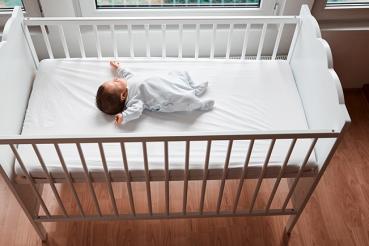Going to the bathroom is something people do many times a day. And usually, we don't have to think about it.
For a child with constipation, however, bathroom trips can be painful, frustrating, stressful, scary or even embarrassing.
When children experience these issues, they are considered to be constipated:
- They have fewer than three bowel movements a week
- They struggle to have bowel movements
- They produce stools that are hard, dry and/or extremely large
- They have to strain to push the stool out (sometimes there's a little blood in the stool)
Constipation may also cause the child to feel bloated or experience sharp — sometimes severe — pain around the belly button.
Combating constipation
Pediatric gastroenterologist Anil Kesavan, MD, and pelvic floor physical therapist Trish Mesch, PT, are among the specialists at Rush who work with children and their parents to address constipation. Here, they offer 5 tips to help overcome this common problem.
1. Fill up on fiber.
It's no secret that fiber — found in fresh fruits and vegetables, and whole grains — helps keep the bowels running smoothly. But many kids simply aren't getting enough, Kesavan says. Combine that with a diet high in fats and processed sugars, and you’ve got a recipe for constipation.
How much fiber do kids need? About 14 grams daily for every 1,000 calories they eat, which translates to the following:
- Toddlers — about 19 grams a day.
- Children ages 4 to 8 — around 25 grams.
- Preteen and teenage boys and girls — anywhere from 26 to 38 grams every day (at these ages, girls should eat fewer calories than boys, so they'll also need less fiber).
Bumping up the fiber in your child's diet doesn't have to mean boring meals and snacks. These kid favorites are also tasty sources of fiber:
- Whole-grain pastas, breads, crackers and cereals
- Fresh apples (unpeeled), bananas, pears, oranges and raspberries
- Oatmeal (sprinkle with diced apple or banana for extra fiber)
- Popcorn (choose low-fat microwave or plain air-popped varieties, and go easy on the salt)
- Pistachios and almonds (just don't overindulge, as nuts are high in calories)
- Edamame (soy beans)
- Hummus (use baby carrots or celery stalks as dippers, or spread on whole grain pita or crackers)
- Graham crackers
- Baked potato or baked sweet potato (with the skin on)
2. Pump up the water.
Water helps keep stool soft, so it moves more smoothly through the intestines. If you're not getting enough water, stool can become harder, which can lead to constipation.
Make sure your kids drink three to four 8-oz. glasses of water each day. If possible, Mesch says, send a full water bottle to school with them so they can stay hydrated throughout the day. If your child's school doesn't allow water bottles, pack one for lunch instead of a juice box or pouch.
Then, serve a big glass of water at dinner. Trading juice for water once or twice a day will also help to reduce your child's daily sugar intake.
3. Be more active.
A bowel at rest tends to stay at rest. The best way to get the bowel moving is to move around.
There are lots of ways to help your kids be more active. Sign them up for a sports or dance class. Shoot some hoops with them. Take them bowling or mini-golfing. Go for a family hike or bike ride. You'll all reap the health benefits — and have fun.
After meals, your digestive system is already moving along, so it's a good time for kids to try having a bowel movement.
4. Make going to the bathroom routine.
Constipation sometimes has a behavioral component. For instance, kids can get in the habit of "holding it in" when they feel the urge to have a bowel movement.
"We see this a lot in school-aged kids," Kesavan says. "Nobody likes to have bowel movements in school. They may feel embarrassed to do it around their classmates, or they're worried they won't have time to sit on the toilet long enough between classes. So they end up holding it in for the entire school day."
However, this can cause the stool to become firmer and more difficult to pass. And fear of a painful bowel movement may then make kids even more reluctant to go. "Sometimes, all it takes is one bad experience to start a vicious cycle," Mesch says.
To help break the cycle, try "toilet time." Have the child sit on the toilet twice a day — after breakfast and after dinner — for 10 to 15 minutes each time. Just be aware that you may need to build in extra time before school so your child doesn’t feel rushed or stressed.
"After meals, your digestive system is already moving along, so it's a good time for kids to try having a bowel movement," Kesavan says. "If they go, great. If not, that's OK, too. But you want them to get back in the habit of going to the bathroom regularly."
5. Work with a physical therapist.
Pediatric pelvic floor physical therapists like Mesch address the physical, behavioral and emotional causes of constipation in kids. In addition to educating parents and children on diet and hydration, they offer a variety of therapeutic approaches, including the following:
- Colon massage – "This is a simple way to encourage normal movement of stool through the colon," Mesch says. "It's an external abdominal massage that's easy to learn, and it's more effective than you might think. Once we teach parents and kids how to do it, they can use it any time."
- Potty posture – "If a child's feet don't touch the ground and they're trying to hold themselves on the toilet, they're tightening muscles that need to be relaxed," Mesch says. Putting a footstool in front of the toilet and correcting the child's posture can make a big difference. "It helps to put the rectum at a better angle, so it's easier for the stool to evacuate."
- Muscle re-training – Sometimes, the problem is that the child is not using the pelvic floor muscles correctly. "Essentially, the child is trying to push stool through a closed hole," Mesch says. To get things in sync, she may use biofeedback, a mind-body technique that trains children to relax and tighten the muscles at the right times. They are able to see and feel the correct way to push, so they can eventually recreate that feeling on their own.
"Our goal is to get the child's bowel function back to normal, which means how it was before the constipation started," says Kesavan. "Sometimes, changing the child's diet a little can help. But for more severe constipation or if there is a behavioral component, you may have to try a combination of approaches before you see results."





